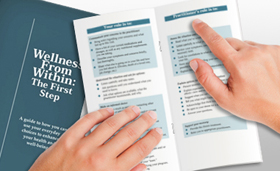Search Results
Menu Ideas for Healthful and Delicious Meals: Part-One

Judy E. Buss
If you have resolved to improve your eating habits, you may be at a loss as to what constitutes well-balanced healthful meals. In this two-part series we will present easy-to-digest information how to construct menus for quick, nutritious, inexpensive, filling, and delicious meals at home!
Healthy eating is not possible without planning when you will actually begin to prepare a meal, just as you schedule a hair appointment or a meeting. After a few weeks of doing so, it’ll feel completely natural – as in “why haven’t I done this before?”
Some cookbooks and food magazines will tell you that you can prepare healthy meals in 15 – 20 minutes. This is rarely possible. However, cooking a meal takes a heck of a lot less time than sitting in doctors’ waiting rooms or rehab centers!
A well-stocked kitchen with basic ingredients provides you with a wide variety of options for all your meals and snacks for an entire week. That means having enough fresh veggies, fruits, eggs, meat, fish, potatoes, sweet potatoes, and yogurt in your fridge; dried herbs and spices, brown rice, old-fashioned oats (oatmeal), quinoa, dry beans, lentils, garlic, onions, olive oil, and salad vinegar, in your pantry. Armed with a thoughtfully prepared shopping list, food shopping only once per week will save you having to make multiple time-and-money-wasting trips to the grocery store for just an item or two.
Some recipes or parts of them can be cooked in double batches (whole grains, beans, soups, stews, etc). This eliminates the need to cook every meal completely from scratch. Keep flavor combinations in mind. For example, avoid having two dishes on your plate with strong and very different flavors. They will clash, cancel each other, or otherwise not taste good.
Maintaining 1 – 2 meatless (vegetarian) days per week is highly recommended for nurturing good health. Start with only one such a day and after a month add a second meatless day for later in the week. Numerous delicious meatless (plant-based) recipes are available.
BREAKFAST:Friends, breakfast is perhaps the most important meal of the day! After fasting for about 10 hours, nourishing your body is imperative for good health, being alert, and having the energy to meet the day’s demands. A little planning can go a long way toward a quick and wholesome foundation for your day. For example, while you are preparing lunch or dinner, cook hard-boiled eggs for the next several breakfasts. Or, when you are washing salad or cooking veggies for dinner, wash some breakfast fruits, dry and refrigerate them in a sealed bag ready to eat. For a nutritious well-balanced breakfast, each day mix and match 2 – 3 options from the following categories: 1)Protein-rich cooked or dry (cold) whole grains and cereals or bread; the fewer ingredients on the label the better, with the whole grain listed first. Avoid cereals containing sugar, syrup, artificial sweeteners, artificial flavors, or colors. 2) Dairy, eggs, and good fats 3) fruit (avoid drinking juices).
Breakfast Menu Examples: Day 1– A bowl of cooked oatmeal, mixed with a pat of butter and cinnamon; one cup low fat milk; one hard-cooked egg; anda piece of fruit. Day 2– A bowl of whole grain cold cereal topped with nuts; 1/2 cup non-sweetened soy milk; 1/2 cup low-fat cottage cheese. Day 3– Two slices toasted whole grain bread with pure, additive-free peanut butter;cup of fresh not canned!) fruit salad.Day 4-A bowl of granola; 1 cup unsweetened almond milk or unsweetened soy milk;low-fat plain additive-free yogurt (read labels!) topped with chopped nuts and/or fruit.
SNACKS:Chain-nibbling on junk food between meals amounts to your daily non-recommended acts of self-sabotage. One sensible portion of a nutritious snack between meals is actually good for your health. It helps control weight by preventing the development of ravenous hunger followed by overeating at mealtime. Snack Ideas:A moderate portion of fruit and three tablespoons nuts; ¼ cup nuts or peanuts; a small veggie sandwich; one cup chopped veggies and ½ cup low-fat cottage cheese or plain yogurt; a small bowl of home-cooked hearty soup with one whole grain pita; a slice of toasted whole grain bread with a slice of quality cheese; one additive-free rice cake spread with pure additive-free peanut butter.
“Mission Nutrition” Tips and Recipies from Judy E. Buss, Health Columnist, Nutritional Cooking Instructor.
Excerpted from Judy E. Buss’ article, first published in the “Feeling Fit” Magazine, Sun Coast Media Group newspapers, Florida.
Stay tuned for more Judy E. Buss’ “Mission Nutrition” words of wisdom and recipes.
























